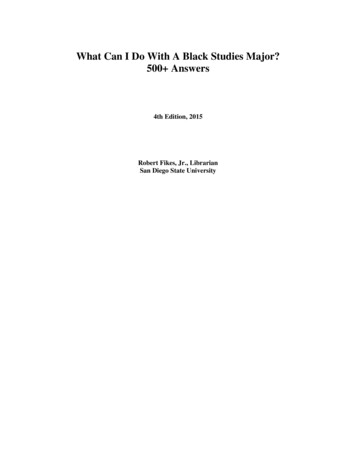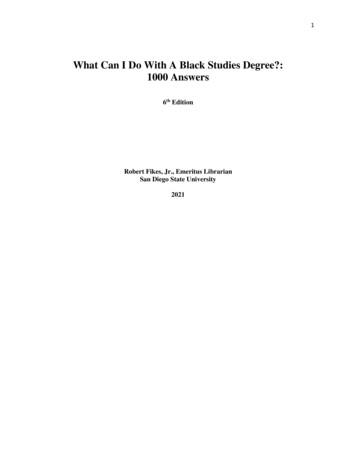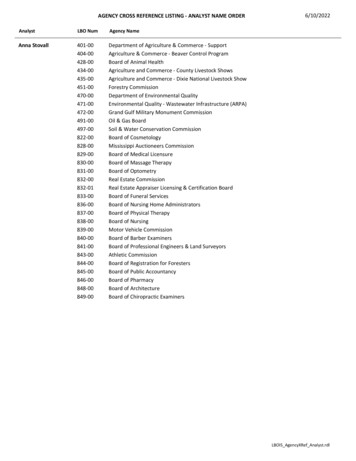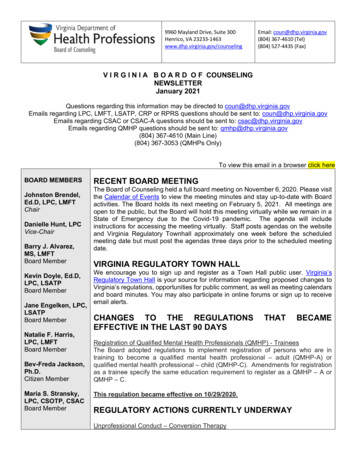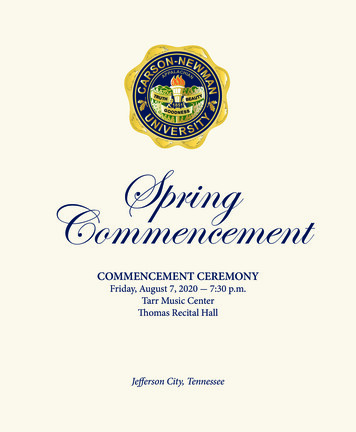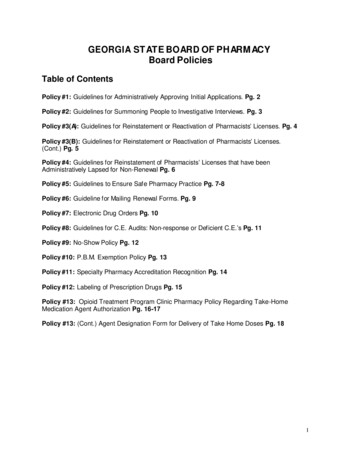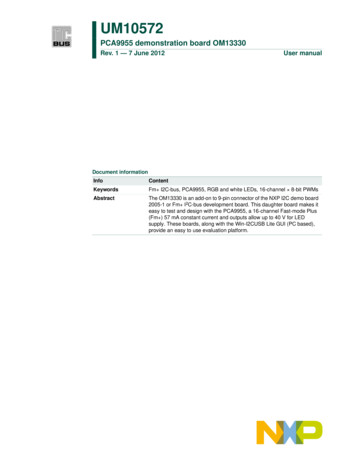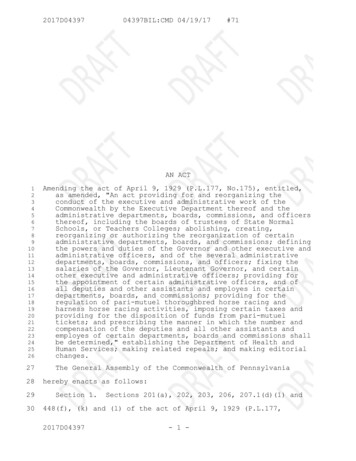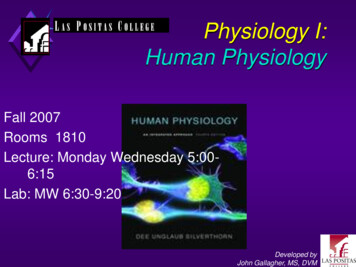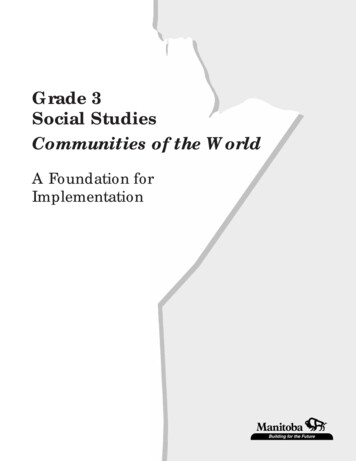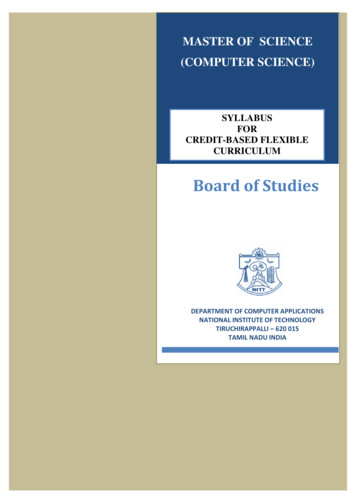
Transcription
MASTER OF SCIENCE(COMPUTER SCIENCE)SYLLABUSFORCREDIT-BASED FLEXIBLECURRICULUM(Applicable for 2018-2019 onwards)Board of StudiesDEPARTMENT OF COMPUTER APPLICATIONSNATIONAL INSTITUTE OF TECHNOLOGYTIRUCHIRAPPALLI – 620 015TAMIL NADU INDIA
About us:The Department of Computer Applications is one of the pioneering departments of theinstitution that offers Information Technology courses namely MCA, M.Sc in ComputerScience and M.Tech in Data Analytics and one among the top five offering MCA course in thecountry. It is committed to impart quality education in the sub-fields of IT, a field growing inleaps and bounds.Vision:Towards a school of Information Science and Technology conforming to internationalstandardsMission:o To offer state-of-art education in Information Science and Technologyo To provide strong theoretical foundation complemented with extensive practicaltrainingo To inculcate value-based, socially committed professionalism to the cause of overalldevelopment of students and societyMASTER OF SCIENCE (COMPUTER SCIENCE)Objectives of the Programme: To impart quality education in the field of Computer Science.To cater to the demands of the IT and IT enabled sectors through strong theoreticalfoundation with high quality teaching complemented with extensive practical training.To inculcate value-based, socially committed professionalism to the cause of overalldevelopment of research attitude and life-long learning.1
The board of studies for Computer Applications Department includes the followingmembers: Chairman:Dr. S.R.BalasundaramHead of the department External Experts:Dr.V.Ramachandran, Professor,Department of Information Science and Technology,Anna University, Chennai.Mr.Krishna RamachnadranPrincipal Education & ResearchInfosys, Chennai. Members:1. Dr. N.P. Gopalan, Professor2. Dr. A.V. Reddy , Professor3. Dr. B. Ramadoss, Professor4. Dr.S.Nickolas, Professor5. Dr. Michael Arock, Professor6. Dr. P.J.A Alphonse, Professor7. Dr. S. Domnic , Associate Professor8. Dr. (Mrs) B.Janet , Assistant Professor9. Dr. (Mrs) S. Sangeetha, Assistant Professor10. Dr. (Mrs). R. Eswari, Assistant Professor11. Dr. U. Srinivasulu Reddy, Assistant Professor12. Dr. C.Sivaraj13. Dr. (Mrs). Adlin Suji14. Ms. Cynthia Devi15. Ms. Jenie Arock16. Mr.K.Vignesh2
SemesterIIIIIIIVSubjectCodeCAS 761Subject NameMathematical FoundationsScienceofLTPCComputer 3003CAS 763Multimedia Communications2103CAS 765Data Structures and Algorithms2103CAS 767Database Technologies2103CAS 769Advanced Operating Systems3003CAS 751Data Structures Lab0042CAS 753Operating SystemsProgrammingLab – Unix & Shell 0042CAS762High Performance Computing3003CAS 764Data Mining and Analytics2103CAS 766Advanced Statistical Techniques for Data 3Science003CAS 768Problem Solving Using Python and R3003XXXXXXElective I3003CAS 752High Performance Computing Lab0042CAS 754DBMS and Data Mining Lab0042CAS 771Web Computing2103CAS 773Artificial Intelligence3003CAS 775Object Oriented Software -III3003CAS 755Project Work- Phase I0042CAS 757FOSS Lab0042CAS 799Project Work –Phase IIGrand Total040050241067L: LECTURE T: TUTORIAL P: PRACTICAL C: CREDITS3
LIST OF ELECTIVESSubjectCodeSubject NameLTPCCAS 7A1Big Data Analytics3003CAS 7A2Computational Intelligence3003CAS 7A3Cyber Security3003CAS 7B1GPGPU Programming3003CAS 7B2Pattern Recognition3003CAS 7B3Cryptography3003CAS 7C1Design Patterns3003CAS 7C2Internet of Things3003CAS 7C3Cloud Computing and Virtualization Fundamentals3003L: LECTURE T: TUTORIAL P: PRACTICAL C: CREDITS4
CAS761 MATHEMATICAL FOUNDATIONS OF COMPUTERSCIENCEObjectives: To acquire skills in solving mathematical and logical problems. To comprehend mathematical principles and logic. To understand fundamental concepts and tools in discrete mathematics withemphasis on their applications to computer science.Set Theory : Sets and operations, properties - power set - methods of proof - relations, graphand matrix of a relation - partial and total orders, well ordering - equivalence relations, classesand properties - functions, 1-1, onto and bijective - composition of relations and functions inverse functions.Mathematical Logic : Propositions and logical operators – Truth table – Equivalences andimplications – Basic laws– Some more connectives – Functionally complete set of connectives– Review of Propositional Calculus - Validity - Satisfiability related concepts - CNF and DNFforms - Conversion of arbitrary propositional formula to CNF or DNF.Graph Theory : Definitions and basic results - Representation of a graph by a matrix andadjacency list - Trees - Cycles - Properties - Paths and connectedness - Sub graphs - GraphIsomorphism - Operations on graphs - Vertex and edge cuts - Vertex and edge connectivity,Spanning Trees, Euler circuits, Hamiltonian graphs.Probability Theory: Sample Spaces- Events - Axioms – Counting – Conditional Probabilityand Bayes’ Theorem – The Binomial Theorem – Random variable and distributions : Meanand Variance of a Random variable-Binomial-Poisson-Exponential and Normal distributions,Correlation and Regression.Sampling Distributions & Descriptive Statistics: The Central Limit Theorem, Distributions ofthe sample mean and the sample variance for a normal population, Sampling distributions (ChiSquare, t, F, z). Test of Hypothesis- Testing for Attributes – Mean of Normal Population –One-tailed and two-tailed tests, F-test and Chi-Square test - - Analysis of variance ANOVA –One way and two way classifications.References:1. Kenneth H. Rosen, “Discrete Mathematics and Its Applications”, 7th Edition, McGrawHill, 2012.2. Kolman, Busby and Ross, “Discrete Mathematical Structures”, 6th Edition, PHI, 2013.3. Sheldon M. Ross,”Introduction to Probability and Statistics for Engineers andScientists”, 5th edition, Academic Press; 2014.Outcome:Students will be able to: Apply the concepts of discrete mathematics in the modeling and design ofCAS763 COMPUTER ORGANIZATION AND ARCHITECTUREcomputational problems.5
CAS763 MULTIMEDIA COMMUNICATIONSObjectives: To understand multimedia content representation and transmission To be familiar with existing state-of-the-art in network protocols, architectures, andapplications. To gain comprehensive knowledge about multimedia data transmission over thenetwork.Introduction, multimedia information representation, multimedia networks, multimediaapplications, media types, communication modes, network types media types, communicationmodes, network types, multipoint conferencing, network QoS application QoS. - MultimediaInformation Representation: Introduction, digital principles, text, images, audio, video.Compression - Text And Image Compression: Introduction, compression principles, textcompression, image compression. - Audio And Video Compression: Introduction, audiocompression, DPCM, ADPCM, APC, LPC, video compression, video compression principles,H.261, H.263, MPEG, MPEG-1, MPEG-2, and MPEG-4Multimedia Information Networks: Introduction, LANs, Ethernet, Token ring, Bridges, FDDIHigh-speed LANs, LAN protocolInternet: Introduction, IP Datagrams, Fragmentation, IP Address, ARP and RARP, QoSSupport,IPv8. - Broadband ATM Networks: Introduction, Cell format, Switch and ProtocolArchitecture ATM LANs.Transport Protocol: Introduction, TCP/IP, TCP, UDP, RTP and RTCP.References:1. Multimedia Communications: Applications, Networks, Protocols and Standards, FredHalsall,Pearson Education, Asia, Second Indian reprint 2002.2. Multimedia Information Networking, Nalin K. Sharda, PHI, 2003.3. Multimedia Fundamentals: Vol 1 - Media Coding and Content Processing, RalfSteinmetz, Klara Narstedt, PearsonEducation, 2004.4. Multimedia Systems Design, Prabhat K. Andleigh, Kiran Thakrar, PHI, 2004Outcomes:Students will be able to: Use and apply appropriate network protocols to transmit multimedia content6
CAS 765 DATA STRUCTURES AND ALGORITHMSObjectives: To learn the basics of programing To learn basic concepts of data structures To design and analyse algorithmsIntroduction – Arrays – Structures – Stack: Definition and examples, Representing Stacks Queues and lists: Queue and its Representation, lists – Applications of Stack, Queue andLinked Lists-Basics of Programming and Data Structures.Binary Trees – Binary Tree Representations – node representation, internal and external nodes,implicit array representation - Operations on binary trees – Binary tree Traversals Representing Lists as Binary Trees–Search Trees.Algorithms – Analyzing and Designing algorithms – Asymptotic notations – Recurrences –Methods to solve recurrences – Basic sorting techniques – selection sort, bubble sort, insertionsort and merge sort – Basic Search Techniques – linear search and binary search.Revisiting various operations of different data structures with time complexity analysis –Design and Analysis of Heap Sort - Quick Sort – Sorting in linear time – Radix sort – Selectionin linear time.Design Strategies: Recursion - Divide and conquer methodology – Multiplication of largeintegers – Strassen's matrix multiplication – Greedy method – Prim's algorithm – Kruskal'salgorithm – algorithm for Huffman codes – Dynamic Programming – Backtracking and Branchand bound method.References1. Stephen Prata,”C Primer Plus”, 6th Edition ,Addison-Wesley Professional, 20112. Bjarne Stroustrup, “Programming: Principles and Practice Using C ,1st Edition,Addison-Wesley Professional, 20083. Bruce Eckel ,”Thinking in C : Introduction to Standard C : Volume One” 2ndEdition,PrenticeHall, 20004. T.H.Cormen, C.E.Leiserson, R.L.Rivest and C. Stein, "Introduction to algorithms", 3rdedition, 2009, MIT Press.5. P. H. Dave and H. B.Dave, “Design and Analysis of Algorithms”, 2009, Pearson EducationIndia.6. S. Lipschutz and G.A.V. Pai, “Data Structures”, 2010, Tata McGraw-Hill.7. Clifford A. Shaffer, “Practical Introduction to Data Structures and Algorithm Analysis”,2000, 2nd edition, Prentice Hall.8. P. Brass, “Advanced Data Structures”, 2008, Cambridge University Press.Outcomes:Students will be able to: Design and implement abstract data types/Data structures. Design and analyse algorithms7
CAS 767 DATABASE TECHNOLOGIESObjectives: To learn different database models and design of databases To study query languages, transaction management, indexing and hashing To be aware of emerging database technologiesDatabase system – Terminologies – Views – Data models – Database languages – Architecture– E-R Model – Conceptual design with E-R – Extended E-R - Relational Model - Codd’s rule- Keys – Constraints – Relational database design – Anomalies - Functional dependencies –1NF to 5NF – Decomposition - DenormalizationRelational Query Languages – Relational Algebra – Tuple and domain Relational Calculus –SQL – Query processing and optimization – Transformation of relational expressions –Evaluation plansTransaction – Properties – Concurrent execution – Serializability – Concurrency control –Protocols – Recovery System – Database SecurityFile organization – Organization of records in files – Indexing – B tree and B tree index files– Static hashing – Dynamic hashingParallel and distributed databases – Object-based databases - Mobile databases - XML andWeb databases – Intelligent databases – Mongo DB – NOSQL - PostgreSQLReferences:1. Silberschatz, Korth and Sudarshan, “Data Base System Concepts”, McGraw-Hill, 6thEdition, 2011.2. R. Elmasri, S.B. Navathe, “Fundamentals of Database Systems”, 7thEdition, PearsonEducation, 2017.3. Raghu Ramakrishnan and Johannes Gehrke, “Data Base Management Systems”, 3rdEdition, McGraw-Hill, 2014.4. C. J. Date, “An Introduction to Database Systems”, 8th Edition, Addison-Wesley, 2006.5. Guy Harrison, “Next Generation Databases”, Apress, 2015.6. Eric Redmond, Jim R Wilson, “Seven Databases in Seven Weeks”, LL. 2012.7. Adam Fowler, “NoSQL for dummies”, John Wiley & Sons, 2015.Outcomes:Students will be able to: Illustrate the features of DBMS and models for designing databases Apply logical database design principles in solving real world problems Describe the nuances of data retrieval methods Acquire the knowledge about emerging database systems.8
CAS 769 ADVANCED OPERATING SYSTEMSObjectives: To understand design of an operating system and services provided by the OS.To understand what a process is and how processes are synchronized andscheduled.To acquire knowledge on different approaches to memory managementTo understand the structure and organization of the file system and disk.To know the concepts of distributed and Mobile operating systemsOperating System concepts - OS Structure – OS Services - System calls – Processmanagement: Process Concept-Operations on process-Cooperating processes- Inter-processcommunication. Process scheduling-Scheduling algorithms.Threads- Multithreading models – Containers - Process synchronization- critical-section –Synchronization hardware – Semaphores – Classic problems of synchronization – criticalregions. Deadlocks: Characterization, Prevention, Avoidance, Detection, and Recovery.Memory Management: Paging, segmentation, Demand Paging, Page Replacement, Allocationof Frames. File Concepts, Access and Allocation Methods, Free Space Management.Disk Structure, Disk Scheduling and Disk Management. Protection and security Case Studies:UNIX, Linux and Windows Operating Systems.Distributed Operating Systems – Distributed system structure, Distributed file system; MobileOperating systemsReferences:1. Abraham Silberschatz, Peter B. Galvin and Greg Gagne, “Operating System Concepts “,8thedition, John Wiley & Sons Inc., 2013.2. Andrew S. Tanenbaum, “Modern Operating Systems”, 4th Edition, Prentice Hall, 2014.3. William Stallings, “Operating Systems: Internals and Design Principles”, 7th Edition,Prentice Hall, 2011.Outcomes:Students will be able to: Use system calls for managing processes, memory and the file system Be familiar with various types of operating systems including UNIX, Linux and windows. Explore the functionalities of distributed and Mobile operating systems.9
CAS751 DATA STRUCURES LABExercises for learning basic features of C and exercises to implement various data structuresfor real world applicationsCourse Outcomes:Students will be able to:1. Write C programs for solving any problems.2. Implement linear and nonlinear data structures to solve real-time problems3. Perform searching and sorting techniques to different application domains4. Implement different design strategies to solve complex problemsCAS 753 OPERATING SYSTEMS LAB – UNIX & SHELLPROGRAMMINGExercises for learning basic features of UNIX and to solve problems using shell programmingCourse Outcomes:Students will be able to:1. Work on the concepts, design, and structure of the UNIX operating system.2. Use basic UNIX Utilities3. Work on UNIX shell programming.10
CAS762 HIGH PERFORMANCE COMPUTINGObjectives: To learn the fundamentals of High Performance Computing.Modern processors-Stored-program computer architecture - General-purpose cache-basedmicroprocessor architecture - Memory hierarchies-Multicore processors - Multithreadedprocessors -Vector processorsParallel computers-Taxonomy of parallel computing -Shared-memory computers- Distributedmemory computers-Hierarchical (hybrid) systems-Networks - Basics of parallelization - Whyparallelize? Parallelism-Parallel scalabilityShared-memory parallel programming with OpenMP-OpenMP - Case study: OpenMP-parallelJacobi algorithm -Advanced OpenMP: Wavefront parallelization- Efficient OpenMPprogramming-Profiling OpenMP programs -Performance pitfalls. Case study: Parallel sparsematrix-vector multiplyLocality optimizations on ccNUMA architectures-Locality of access on ccNUMA-Case study:ccNUMA optimization of sparse MVM-Placement - ccNUMA issues with C Distributed-memory parallel programming with MPI-Message passing –MPI - Example: MPIparallelization of a Jacobi solver - Efficient MPI programming- Hybrid parallelization withMPI and OpenMP-Basic MPI/OpenMP programming models - MPI taxonomy of threadinteroperability-Hybrid decomposition and Potential benefits and drawbacks of hybridprogrammingReferences:1. G.Hager and G.Wellein, “Introduction to High Performance Computing for Scientistsand Engineers”, Taylor & Francis, 2017.2. R.A. Kudale and S.Y.Kulkarni, “High Performance Computing”, VishwakarmaPublications, 2016.3. T.Sterling, M.Anderson and M.Brodowicz, “High Performance Computing: ModernSystems and Practices”, Morgan Kaufmann, 2018.Outcomes:Students will be able to: Deal with fundamental design issues in HPC Design parallel algorithms and handle advanced tools, techniques 3.handle advanced tools and techniques 11
CAS764 DATA MINING AND ANALYTICSObjectives: To introduce the basic concepts and techniques of data mining and analytics. To develop skills of using recent data mining and analytics software for solvingproblems. To be aware of advanced concepts of data mining and analytics techniques and itsapplications in the knowledge discovery process.Data Mining Techniques-Data Mining Process-Process with a typical set of data- Data AnalyticTechniques-Big Data-Visualization of data through data mining and analytical software.Data Mining Methods as Tools - Memory-Based reasoning methods of Data Mining Algorithms with prototypical data based on real applications using data analytical methods.Data Stream Mining, Mining Time Series, Text Mining, Data Stream Clustering, mining BigData through data mining and analytical tools.Market Basket Analysis - Fuzzy Data Mining approaches - Fuzzy Decision Tree approachesFuzzy Association Rule applications. Rough Sets - Support Vector Machines - Geneticalgorithms. Case studies.Social Computing - Analysis -Graph Mining – Social Network Mining-Web Mining – WebUsage Mining-Privacy Preserving Data Mining-Recommender Systems. Case studies.References:1. David L. Olson and Dursun Delen, “Advanced Data Mining Techniques”, Springer,2008.2. Charu C. Aggarwal and Haixun Wang, “Managing and Mining Graph Data”, Springer,2010.3. Ian H. Witten, Eibe Frank and Mark A. Hall, “Data Mining: Practical Machine LearningTools and Techniques”, Morgan Kaufmann Publishers, 2011.4. Jiawei Han and Micheline Kamber, “Data Mining: Concepts and Techniques”, MorganKaufmann Publishers, 2006.5. Margaret H. Dunham, “Data Mining Introductory and Advanced Topics”, PrenticeHall, 2003.6. Anand Rajaraman and Jeff Ullman, “Mining of Massive Datasets”, CambridgeUniversity Press, 2011.7. Wolfganag, J., Business Analytics for managers, Spinger, 2011.Outcomes:Students will be able to: Understand the concepts and algorithms of data mining and analytics. Apply data mining and analytic techniques for business intelligence. Be aware of the privacy and security issues in data mining and analytics.12
CAS766 Advanced Statistical Techniques for Data ScienceObjectives: To understand advanced statistical techniques To gain comprehensive knowledge on applications of statistical techniques for dataanalysisPrinciples of statistical inference- Formulation of problems with examples- Point estimation.Estimator and estimate-Criteria for good estimates. Method of moments estimation andmaximum likelihood estimation - Fisher Information matrix- Properties of maximumlikelihood estimator-Confidence intervals.Basic multivariate statistics: multivariate descriptive statistics, multivariate distributions(normal, etc), multivariate inferential statistic.Multivariate data- Analysis of variance (ANOVA), Multivariate analysis of variance(MANOVA)- Case study: MANOVAMultiple linear regression- Multiple and partial correlation- Detection of Collinearity-Stepwiseregression.Validation of model assumptions- Detection of outliers- influential observation andautocorrelationReferences:1. Joseph F. Hair Jr,Rolph E. Anderson, Ronald L Tatham, and , Multivariate data analysisby Fifth Edition, Pearson Education, 1998.2. R A Johnson and D W Wichern, Applied multivariate statistical analysis, Sixth Edition,PHI, 2012.3. D. C. Montgomery and G. C. Runger, Applied Statistics and Probability for Engineers,6th Edition, Wiley, 20144. G.K. Bhattacharya and R.A. Johnson, Statistical Concepts & Methods, 6th Edition,Wiley, 20105. D.C. Montgomery and E. Peck., Introduction to Linear Regression Analysis – 5thedition, wiley, 20126. W.J.Conover, Practical Nonparametric Statistics, Wiley, 3rd Edition, 1998Outcomes:Students will be able to: Apply statistical techniques for real time data analysis applications13
CAS768 PROBLEM SOLVING USING Python and RObjectives: To write simple Python programs using Python data structures. To develop object oriented programs in Python To manipulate files using Python. To work on few python packages To write simple R programs for statistical computing.Problems solving fundamentals, Python: variables, expressions, statements, precedence ofoperators; Data structures: list, Dictionary, tuples; Lists: list slices, list methods, mutability,cloning lists, List comprehension; Tuples: tuple assignment, tuple as return value; Dictionaries:operations and methods; Conditional constructs; Iterative constructs. Strings: string slices,immutability, string functions and methods;Functions: parameters, return values, local and global scope, function composition, recursion,and lambda functions;Object orientation – Classes, Objects, methods, Operator overloading, and Inheritance. Filesand exception: text files, reading and writing files, format operator; errors and exceptions,handling exceptions; creating modules and packages;Python Modules and Packages: Python Standard Library, Numpy, Pandas, Matplotlib, GUITkinter, wxWidgets ; Database- MySQLDB, Scikit-Learn, NLTKR Programming - Control Structures - Functions - Data Manipulation - String Operations- DataVisualization – R for Statistical computing.References:1. Allen B. Downey, “Think Python: How to Think like a Computer Scientist”, 2ndedition, Updated for Python 3, O‘Reilly Publishers, 20162. Zed Shaw's ,”Learn Python the Hard Way: A Very Simple Introduction to theTerrifyingly Beautiful World of Computers and Code, Addison-Wesley Professional;3 edition, 20133. Robert Sedgewick, Kevin Wayne, Robert Dondero, Introduction to Programming inPython: An Inter - disciplinary Approach, Pearson India Education Services Pvt. Ltd.,2016.4. Paul Teetor, R Cookbook- Proven Recipes for Data Analysis, Statistics, and Graphics,O'Reilly Media, 20115. Wesley J Chun, Core Python Programming , 2nd edition, Prentice Hall ,2009Outcomes:Students will be able to: Write programs using Python data structures. Develop solutions to real world problems using object oriented concepts Read and write data from/to files using Python. Make use of Python Modules and Packages to solve complex problems Write simple R programs for statistical computing.14
CAS752 HIGH PERFORMANCE COMPUTING LABExercises to implement parallel algorithms using openMP, MPI etc. with CUDA and otherarchitectures.Course Outcomes:Students will be able to:1. Investigate modern design structures of pipelined and multiprocessors systems.2. Write algorithms using parallel programming principle.3. Design the architecture of parallel systems.CAS754 DBMS AND DATA MINING LABExercises to construct and query databases.Exercises to implement Data mining algorithms using ENCOG and WEKACourse OutcomeStudents will be able to:1. Work with ETL tools2. Demonstrate the classification, clustering and etc. in large data sets.3. Ability to add mining algorithms as a component to the exiting tools.4. Ability to apply mining techniques for realistic data.15
CAS771 WEB COMPUTINGObjectives: To comprehend basics of the internet and web terminologies. To introduce scripting language concepts for developing client side applications. To practice server side programming features – ASP .NET, PHP, JSP. To be familiar with database applications To know the usefulness of web services.Internet and World Wide Web : Introduction to Internet, www, Internet browsers Netscape &Explorer, Introduction to Client Server Architecture/Computing, History of the web, Growthof the web, Protocols governing the web, resources of Internet, H/W & S/W requirements ofInternet, Internet service providers, Internet Services, Internet Clients and Internet Servers.Concept of E-Commerce and E-governance.Markup Languages: Introduction to HTML, Formatting Tags, Links, Lists, Tables, Frames,Forms, Comments in HTML, DHTML and XML Documents, Data Interchange with an XMLdocument, Document type definition, Features and Applications, Working with Style sheets.Client Side Scripting: Scripting basics, Introducing JavaScript, Documents, Statements,Functions, Objects in javascript, Events and Event handling, Arrays, Forms, Buttons,Checkboxes, Text Fields and Text Area.Server Side Scripting: Introduction to server side scripting language, RMI, The Problem withServelet. JSP Application Design with MVC Setting Up and JSP Environment: Installing theJava Software Development Kit, Tomcat Server & Testing Tomcat- Generating DynamicContent, Using Scripting Elements Implicit JSP Objects, Conditional Processing – DisplayingValues Using an Expression to Set an Attribute, Declaring Variables and Methods ErrorHandling and Debugging - Sharing Data Between JSP pages, Requests and Users PassingControl and Date between Pages – Sharing Session and Application Data – Memory UsageConsiderationsPHP Basic command with PHP examples, Connection to server, creating database, selecting adatabase, listing database, listing table names creating a table, inserting data, altering tables,queries, deleting database, deleting data and tables, PHP myadmin and database bugs.References:1.2.3.4.5.John Pollock, “Javascript : A biginers Guide”, McGraw HillMercer, “ASP 3.0: A Biginers Guide”, McGraw HillShelly Powers et al., “Dynamic web publishing ”, Techmedia, 1998.Scot Johnson et. al., “Using Active Server Pages”, Que, 1997.E-Commerce – Cutting Edge of Business – Kamlesh K. Bajaj, Debjani Nag – TataMcGraw Hill,1/e, 2003Outcomes:Students will be able to: Design and develop web applications. Understand client and server side scripting and their applicability.16
CAS773 ARTIFICIAL INTELLIGENCEObjectives: To explore various AI search algorithmsTo understand fundamentals of knowledge representationTo acquire knowledge on the basic concepts and techniques of Machine Learning.To gain knowledge on the applications of AI.Philosophy of artificial intelligence, problem solving, search techniques, constraintsatisfaction, and game playing - minimax, handling uncertainty: probability theory, BayesianNetworks.Knowledge representation and reasoning: predicate logic, rule based systems, Decision tree,Semantic networks, Ontology, Basics of Semantic WebMachine learning- Supervised learning- Regression, Classification; unsupervised learningClustering; Reinforcement learning.Computational Intelligence- Fuzzy systems, Swarm intelligence, neural networks modelsLearning through neural nets; Basics of Deep learningApplications of Artificial Intelligence- Natural Language Processing, Speech recognition,Computer vision, Expert systemsReferences:1. Richard E. Neapolitan, Xia Jiang, Artificial Intelligence -With an Introduction to MachineLearning, Second Edition, CRC press, 20182. Ertel, Wolfgang, “Introduction to Artificial Intelligence”, 2nd edition, Springer, 20173. Ethem Alpaydin, Machine Learning – The New AI, MIT press, 20164. Wilber Fankhause, Artificial Intelligence Applications: Natural Language Processing,CreateSpace Independent Publishing Platform, 2015.Outcomes:Students will be able to: Know how to build simple knowledge-based systems Apply knowledge representation and machine learning techniques to solve realworld problems Apply Computational Intelligence techniques to solve real-world problems17
CAS 775 OBJECT ORIENTED SOFTWARE ENGINEERINGObjectives : To comprehend basics of the software engineering process life cycle. To be introduced to the object-oriented (OO) approach to softwaredevelopment, through OO principles. To be conversant with UML (Unified Modelling Language) and the benefits ofvisual modeling / diagramming. To get introduced to software engineering principles for both procedural andobject oriented approaches.Introduction -What is software engineering? – Software Development Life Cycles Models Conventional Software Life Cycle Models- What is Object Orientation? – Objects and Classes– Features - Object Oriented Software Life Cycle Models -Object oriented Methodologies –Object – Oriented Modeling –Terminologies.Software Requirements Elicitation and Analysis - Case Study: Library Management SystemWhat is Software Requirement? – Requirements Elicitation Techniques – Characteristics of agood Requirement- Software Requirements Specification Document - Requirements ChangeManagement - Object Oriented Analysis - Overview of Cost Estimation Techniques - Agiledevelopment – Classification of methods – The agile manifesto and principles – Agile projectmanagement Agile Methodology - Method overview – Lifecycle – Work products, Roles andPractices values – Process mixtures – Adoption strategies – Understanding SCRUM.Software Design - Object Oriented Design - What is done in object oriented design? – UML Refinement of Use Case Description – Refinement of classes and relationships - – Constructionof Details class diagrams - Development of Details Design and Creation – Generating Testcases from User Cases – Object Oriented Design principles for Improving Software Quality.Software Implementation - Quality and Metrics -Software Implementation – Tools andTechniques - What is software quality? – Software quality models - Measurement basic analyzing the metric data - Metrics for measuring size and structure – Measuring softwarequality object oriented metrics – Overview of Scala for Implementation.Software Testing and Maintenance -What is software testing? – Software verificat
To be familiar with existing state-of-the-art in network protocols, . 1. Stephen Prata,"C Primer Plus", 6th Edition ,Addison-Wesley Professional, 2011 2. Bjarne Stroustrup, "Programming: Principles and Practice Using C ,1st Edition, Addison-Wesley Professional, 2008 3. Bruce Eckel ,"Thinking in C : Introduction to Standard C .

